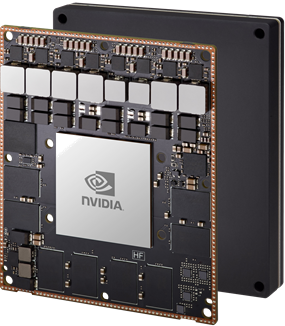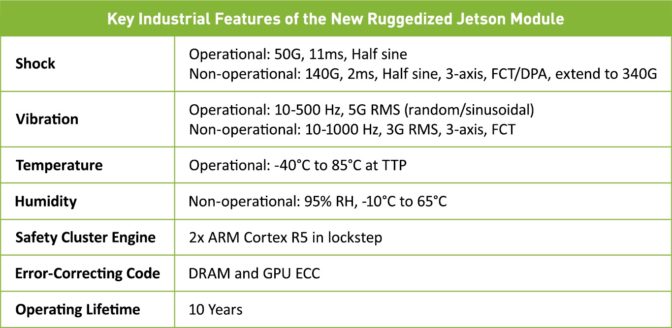From factories and farms to refineries and construction sites, the world is full of places that are hot, dirty, noisy, potentially dangerous — and critical to keeping industry humming.
These places all need inspection and maintenance alongside their everyday operations, but, given safety concerns and working conditions, it’s not always best to send in humans.
Robotics and automation are increasingly used in manufacturing, agriculture, construction, energy, government and other industries, but many companies have struggled to incorporate the benefits of AI and deep learning in the most demanding applications.
With the new NVIDIA Jetson AGX Xavier Industrial module, NVIDIA is making it possible to deploy AI at the edge in harsh environments where safety and reliability are critical priorities.

Extending the capabilities of the Jetson AGX Xavier system-on-module, this new industrial module allows developers to build advanced, AI-enabled ruggedized systems. Jetson AGX Xavier Industrial is built for intelligent video analytics, optical inspection, robotics, computer vision, autonomy and AI in the toughest environments.
It comes in a compact, power-efficient design and reliably delivers up to 30 trillion operations per second (TOPS) of AI performance. Built with components tested to demanding industrial standards and including new functional safety capabilities, it’s able to withstand severe shock and vibration and extreme temperature ranges. And it’s pin-, software- and form-factor compatible with the existing Jetson AGX Xavier module, so upgrading is easy.
Built for the Most Demanding Industrial Use Cases
The Jetson AGX Xavier Industrial is targeted for applications in industrial, aerospace, defense, construction, agriculture, logistics, inventory management, delivery, inspection and healthcare. Applications enabled across these sectors include worker and site safety, site access and monitoring, and inspection in hazardous and harsh environments, among others.
In the oil and gas industry, the Jetson AGX Xavier Industrial streamlines anomaly and failure predictions at the edge by providing real-time insights based on monitoring or inspection of pipelines, valves, equipment and maintenance work. The extended reliability of the module allows it to be used in safety, predictive maintenance and compliance and where equipment remains always-on in changing environmental conditions.
In automobile manufacturing facilities, a factory producing more than 1,000 vehicles a day needs to inspect over 6 million welding points on the fly. Using AI and computer vision on the Jetson AGX Xavier Industrial, it can analyze process and quality data directly from weld guns, which reduces inspection time, improves quality prediction and ultimately helps deliver safer cars to consumers.
Another example was presented at GTC21, where AI-driven anomaly detection in die-casting processes enables early prediction of product quality, avoiding further process costs by up to 30 percent and decreasing defect rates by up to 40 percent. The result is more efficient and safer processes, improving productivity and return on investment.
Similarly, construction sites employ heavy equipment that must operate reliably in various climates. Farms require tractors that can carry fertilizers and herbicide sprayers, and harvest thousands of acres of crops on various terrains. Unmanned aerial vehicles and drones can experience extreme shock and vibration while flying in harsh environments. Point-of-care ultrasounds and patient monitors require consistent operation over long lifetimes.
Jetson AGX Xavier Industrial provides the features necessary to bring autonomy to all of these machines.
Designed for Reliability, Safety and Security
Jetson AGX Xavier Industrial combines the supercomputing capabilities of the Jetson AGX Xavier system-on-module with new reliability, availability and serviceability features required to deploy AI in tough environments. These include error correction codes, single error correction, double error detection and parity protection to deliver internal RAM resilience, address and data bus error detection and correction and IP resiliency in industrial applications.
The module comes with functional safety capabilities supervised by the Safety Cluster Engine (SCE), making it suitable for safety-certified industrial-grade products. In addition, it has the same key accelerators and high-speed I/Os included with Jetson AGX Xavier.
Jetson AGX Xavier Industrial features a 512-core NVIDIA Volta GPU with 64 Tensor Cores, two NVIDIA deep learning accelerators, two vision accelerators, an eight-core NVIDIA Carmel Arm CPU, an encoder and decoder, and more. The new SCE contains dual Arm Cortex-R5 processors that can be used for integrated fault-detection mechanisms, lock-step subsystems and enables built-in-system test. The Cortex-R5, which is in an always-on domain, can be used for safety and error correction functions.
It also includes hardware-verified secure boot, hardware-accelerated cryptography, support for encrypted storage, memory, and other security features to protect customer software.
Check out the full specifications.
Software Support to Easily Build and Manage Industrial AI Deployments
Powered by the NVIDIA CUDA-X accelerated computing stack and JetPack SDK support, Jetson AGX Xavier Industrial is a fully software-defined platform enabling cloud-native capabilities. NVIDIA’s CUDA-X acceleration, free production-ready pretrained models on NGC and NVIDIA TAO Toolkit give developers the fastest path to build and deploy deep learning and AI training and inference systems.
With the use of Jetson AGX Xavier Industrial and JetPack, customers can easily maintain and update ruggedized and safety critical systems in the field using cloud-native technologies for orchestration and management.
Getting Started and Availability
The new Jetson AGX Xavier Industrial module is available to order now and will be available in late July. Developers can start building the smartest edge and embedded systems for their industrial applications today using the Jetson AGX Xavier Developer Kit, downloading JetPack and designing with all the documentation available on the NVIDIA Jetson site.

